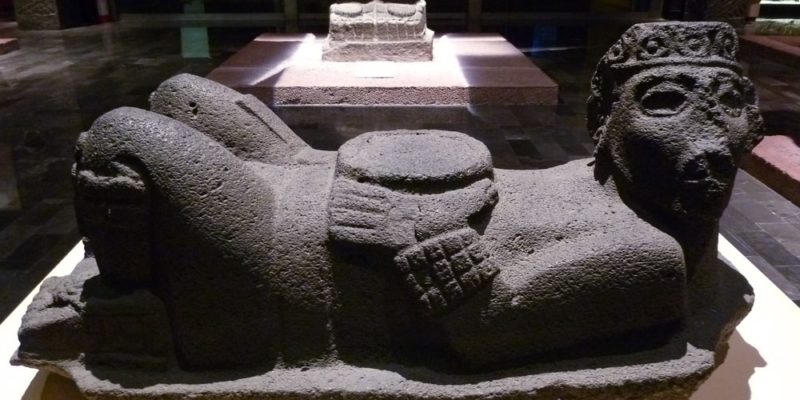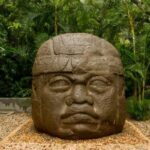We explain what the Toltec culture was, its history, religion, economy and other characteristics. Furthermore, its main contributions.

What was the Toltec culture?
The Toltec culture was a pre-Columbian civilization Mesoamerica. It inhabited the area of current central Mexico since the end of the Classic period, around 800 AD. C., and had its time of splendor at the beginning of the Postclassic period, between 900 and 1168 AD. c.
In the Nahuatl language, spoken by the Aztecs or Mexica, toltec It means “inhabitant of Tula” (after the capital city of this town, called Tula or Tollan Xicocotitlan) and also acquired the meaning of “craftsman”, because the Toltecs were great builders and craftsmen, and the Aztecs considered them precursors of their own culture.
The religious and astronomical knowledge of the Toltecs influenced most of the indigenous peoples mesoamericans who considered the Toltec lineage as a sign of respect and authority.
Other Mesoamerican cultures were: Teotihuacan culture, Aztec culture, Mayan culture, Olmec culture, Totonac culture, Zapotec culture, Mixtec culture.
Key points
- The Toltec culture emerged in 800 AD. C. in central Mexico and had its period of splendor between 900 and 1168 AD. c.
- Its main city was Tula and it was noted for its architecture, its pottery and its sculpture, especially its “Atlantes” and decorated columns.
- It promoted extensive commercial activity throughout Mesoamerica, occupied Mayan cities in Yucatan and influenced other cultures (such as the Mayans and Aztecs).
- Tula was sacked and destroyed by the Aztecs in the mid-12th century AD. C and the Toltec culture declined.
History of Toltec culture
The Toltecs derived from the Toltec-Chichimec peoples who during the 9th century AD. C. they migrated from the northwestern deserts to the Valley of Mexico. There they established the first important settlement, the city of Tollan or Tula, which meant “place of reeds,” an ancient Mesoamerican expression that referred to all large settlements.
The city of Tula grew to cover an area of fourteen square kilometers and housed a population of approximately forty thousand inhabitants. Besides, It became the capital of the Toltec State which spread to the entire Valley of Mexico and surrounding areas.
The Toltecs had a monarchical socio-political organization and great military power, with which they managed to conquer many neighboring lands. In addition, they influenced other Mesoamerican cultures, such as the Mayans of the Yucatan Peninsula.
According to Aztec tradition, the first Toltec leader was Ce Técpatl Mixcoatl. your son Ce Acatl Topiltzin acquired fame as a great ruler, that during the 10th century AD. C. ensured the unity of the State and brought prosperity to its population. He was associated with the god Quetzalcóatl and his reign was considered the golden age of Tula.
It is unknown exactly how the end of the Toltec civilization occurred although some hypotheses indicate that it could have been a consequence of natural phenomena (such as sustained droughts over time) or internal disputes for power (as suggested by mythical stories about battles between the gods Quetzalcóatl and Tezcatlipoca).
Besides, in the middle of the 12th century AD. C. the city of Tula was sacked and destroyed by the Aztecs, as evidenced by the archaeological remains of columns and statues deliberately burned and buried. From then on, the Toltec State was fragmented and the Valley of Mexico was occupied by the Aztecs.
Location of the Toltecs

Initially, the Toltecs were a group of nomadic people from northwest Mexico, identified by researchers as Toltec-Chichimecas, who traveled through various regions. Around 800 AD. c. settled in the north of the Valley of Mexico and soon founded the city of Tula in the current state of Hidalgo, located about 70 km from what is now Mexico City.
Later, they expanded to the surroundings of Tula and formed a State centered in that city. Despite having occupied only the Valley of Mexico and some surrounding areas, they exerted a strong influence on other communities and on the development of important contemporary and later cultures, such as the Aztecs or Mexica and the Postclassic Mayans. They also carried out migrations and occupied Mayan cities in the Yucatan Peninsula.
Characteristics of Toltec culture

Toltec culture was characterized by:
- Your commercial network. The Toltecs traded textiles, ceramics, and obsidian products with neighbors near and far, although on a smaller scale compared to the Mayan trade network. Toltec ceramic objects were found in very distant places, and trade networks reached as far as Costa Rica and northern Mexico.
- Their cult practices to Quetzalcoatl. The Toltecs worshiped the god Quetzalcoatl, the feathered serpent. Images of feathered serpents date back to the ancient Olmecs, the first great Mesoamerican civilization. However, it is believed that it was the Toltecs who extended their cult to various territories, from Tula to Yucatán.
- His warrior vocation. The Toltecs were a religious and warrior people, who spread the cult of the god Quetzalcoatl in the territories under their rule and even beyond. The warriors wore chest plates, a small shield on one arm, and a helmet with a feather headdress. They used short weapons, spear propellers or darts known as atlatl, and a heavy weapon of curved shape, similar to an axe.
- Their practices of human sacrifice. The Toltecs left evidence of their religious practices, which they carried out regularly in order to satisfy their gods. One of the most notable evidence is a type of statue known as “chac mool”, made up of the figure of a reclining human being holding a bowl, where different offerings were placed for the gods, including, possibly, human sacrifices.
- Its artists and builders. The Toltecs were noted for their sculptures, such as the statues known as “Atlantes,” which represented warriors, and the columns that portrayed feathered serpents. Although the archaeological site of Tula was looted repeatedly, vestiges of the artistic greatness of the Toltecs have endured.
- Its connection with Chichén Itzá. The Toltecs settled in Tula (70 kilometers north of present-day Mexico City). However, the city of Chichén Itzá (in Yucatán) shares similarities with the Toltec city, both architecturally and thematically, that go beyond the simple worship of the same gods. Some archaeologists assume that the Toltecs conquered Chichén Itzá in the 10th century AD. C. or that the Toltec nobles settled there and spread their knowledge.
- Its mysterious decline. The Toltecs were a warlike and violent people. This suggests that its decline could be related to the discontent of the subject populations or to conflicts between rival factions, perhaps all stimulated by climatic difficulties. In the middle of the 12th century AD. C. the city of Tula was burned and looted, mainly by the Aztecs but possibly also by neighboring Chichimec tribes.
- Your hidden treasures. The Toltec culture disappeared almost a thousand years ago. However, after numerous lootings (first by the Aztecs and then by the Spanish) cultural objects could still be found buried in the territory they had inhabited. In 1993, a decorative chest was found containing the famous “Tula cuirass,” a suit of armor made from seashells.
Religion of the Toltec culture

The religion practiced by the Toltecs was polytheistic. They mainly worshiped two gods: Quetzalcóatl and Tezcatlipoca, and they had different ceremonial centers where they practiced rituals. One of the most important was Pyramid B, in the city of Tula, which still preserves four monumental anthropomorphic figures known as the “Atlanteans of Tula.”
Several pyramids served as temples dedicated to the gods. However, as a result of looting and destruction, it is difficult to know the history of each structure. It can only be identified that the temples were built with an intentional orientation, with a specific direction from east to west that accompanied the movement of the sun and the moon.
The Toltecs too practiced ball games and human sacrifices. In Tula, several stone sculptures called “chac mool” were found, which consist of a human figure reclining face up and it is believed that they were used to deposit offerings or make sacrifices.
Economy of Toltec culture
The Toltec economy was based on agriculture through extensive crops supplied by a complex system of irrigation canals. They grew cotton, maguey, corn, chili and beans. Crafts, especially pottery and precious stone work, were also part of its economic development.
The Toltecs were characterized by being great merchants who established long-distance exchange relationships, and could supply themselves with other raw materials through war with nearby towns, by obtaining loot or tribute.
Subsistence based on agriculture promoted continued population growth, but this could be a problem during times of drought. For this reason, some explain the decline of Toltec culture from the effects of climate change.
Contributions of Toltec culture
The Toltecs had a certain prestige in Mesoamerica, so other civilizations (such as the Mayans and the Aztecs) appreciated Toltec practices in art, architecture, religion, writing, and medicine. The Aztecs used the expression toltecáyotlwhich meant “toltequity” (the set of Toltec arts and institutions), in reference to those who were worthy and excelled in all actions.
Toltec artisans were famous for their great skill and they established standards that other Mesoamerican civilizations tried to follow. They were skilled potters and expert goldsmiths who worked metals (such as gold). They also worked precious stones (such as jade and obsidian), which they used mainly to make jewelry, decorative objects and weapons.
Besides, stood out in architecture: Although the pyramids existed in Mexico long before the Toltecs, they introduced innovations in the sculpture of columns, friezes and other architectural details.
References
- Britannica, Encyclopaedia (2022). Toltec. Encyclopedia Britannica. https://www.britannica.com/
- Cartwright, M. (2018). Toltec Civilization. World History Encyclopedia. https://www.worldhistory.org/
- López Austin, A. & López Luján, L. (2001). The indigenous past. Economic Culture Fund-El Colegio de México.
- Manzanilla, L. & López Luján, L. (coords.) (2001). Ancient History of Mexico. 4 vols. National Institute of Anthropology and History.
- von Wobeser, G. (ed.) (2014). History of Mexico. Economic Culture Fund.





